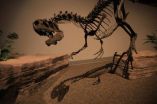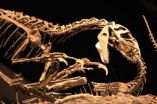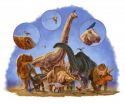(Press-News.org) Scientists have used state-of-the-art imaging techniques to examine the cracks, fractures and breaks in the bones of a 150 million-year-old predatory dinosaur.
The University of Manchester researchers say their groundbreaking work – using synchrotron-imaging techniques – sheds new light, literally, on the healing process that took place when these magnificent animals were still alive.
The research, published in the Royal Society journal Interface, took advantage of the fact that dinosaur bones occasionally preserve evidence of trauma, sickness and the subsequent signs of healing.
Diagnosis of such fossils used to rely on the grizzly inspection of gnarled bones and healed fractures, often entailing slicing through a fossil to reveal its cloying secrets. But the synchrotron-based imaging, which uses light brighter than 10 billion Suns, meant the team could tease out the chemical ghosts lurking within the preserved dinosaur bones.
The impact of massive trauma, they discovered, seemed to be shrugged off by many predatory dinosaurs – fossil bones often showed a multitude of grizzly healed injuries, most of which would prove fatal to humans if not medically treated.
Dr Phil Manning, one of the paper's authors based in Manchester's School of Earth, Atmospheric and Environmental Sciences, said: "Using synchrotron imaging, we were able to detect astoundingly dilute traces of chemical signatures that reveal not only the difference between normal and healed bone, but also how the damaged bone healed.
"It seems dinosaurs evolved a splendid suite of defence mechanisms to help regulate the healing and repair of injuries. The ability to diagnose such processes some 150 million years later might well shed new light on how we can use Jurassic chemistry in the 21st Century."
He continued: "The chemistry of life leaves clues throughout our bodies in the course of our lives that can help us diagnose, treat and heal a multitude of modern-day ailments. It's remarkable that the very same chemistry that initiates the healing of bone in humans also seems to have followed a similar pathway in dinosaurs."
Co-author Jennifer Anné said: "Bone does not form scar tissue, like a scratch to your skin, so the body has to completely reform new bone following the same stages that occurred as the skeleton grew in the first place. This means we are able to tease out the chemistry of bone development through such pathological studies.
"It's exciting to realise how little we know about bone, even after hundreds of years of research. The fact that information on how our own skeleton works can be explored using a 150-million-year-old dinosaur just shows how interlaced science can be."
Professor Roy Wogelius, another co-author from The University of Manchester, added: "It is a fine line when diagnosing which part of the fossil was emplaced after burial and what was original chemistry to the organism. It is only through the precise measurements that we undertake at the Diamond Synchrotron Lightsource in the UK and the Stanford Synchrotron Lightsource in the US that we were able to make such judgments."
INFORMATION:
Notes for editors:
A copy of the paper, 'Synchrotron imaging reveals bone healing and remodelling strategies in extinct and extant vertebrates,' as well as stunning high-resolution images are available on request.
Gnarled predatory dinosaur skeleton coming to UK:
This study proves that there is still a plethora of new information that can be gleaned from specimens within museum collections and the research will be on show at this year's Royal Society Summer Science, which runs from 1 to 6 July in London. The centrepiece of the X-Appeal Exhibit will be a 7.3-metre-long predatory dinosaur, Gorgosaurus, surrounded by a series of experiments exploring how to use the electromagnetic spectrum to image, analyse and investigate this dinosaur's rather gruesome past. The week-long science festival features 22 exhibits from the forefront of British innovation. You can meet the scientists behind cutting edge science and technology exploring everything from antibiotics to x-rays.
For further information about the Royal Society Summer Science Exhibition contact Nicola Kane in the Royal Society Press Office on 0207 451 2508 or visit http://sse.royalsociety.org/2014. A press preview will be held on Monday, 30 June.
For further information contact:
Aeron Haworth
Media Relations
Faculty of Engineering and Physical Sciences
The University of Manchester
Tel: +44 (0) 161 275 8387
Mob/Cell: +44 (0) 7717 881563
Email: aeron.haworth@manchester.ac.uk
Or Dr Phil Manning
Director, Interdisciplinary Centre for Ancient Life
School of Earth Atmospheric and Environmental Sciences
The University of Manchester
Mob/Cell: +44 (0) 7983 444 764
Email: phil.manning@manchester.ac.uk
Revealing the healing of Dino-sores
2014-05-07
ELSE PRESS RELEASES FROM THIS DATE:
Study finds pregnant women show increased activity in right side of brain
2014-05-07
Pregnant women show increased activity in the area of the brain related to emotional skills as they prepare to bond with their babies, according to a new study by scientists at Royal Holloway, University of London.
The research, which will be presented at the British Psychological Society's annual conference on Wednesday 7 May, found that pregnant women use the right side of their brain more than new mothers do when they look at faces with emotive expressions.
"Our findings give us a significant insight into the 'baby brain' phenomenon that makes a woman more sensitive ...
Mass vaccination campaigns reduce the substantial burden of yellow fever in Africa
2014-05-07
Yellow fever, an acute viral disease, is estimated to have been responsible for 78,000 deaths in Africa in 2013 according to new research published in PLOS Medicine this week. The research by Neil Ferguson from Imperial College London, UK and colleagues from Imperial College, WHO and other institutions also estimates that recent mass vaccination campaigns against yellow fever have led to a 27% decrease in the burden of yellow fever across Africa in 2013.
Yellow fever is a serious viral disease that affects people living in and visiting tropical regions of Africa and ...
Water from improved sources is not consistently safe
2014-05-07
Although water from improved sources (such as piped water and bore holes) is less likely to contain fecal contamination than water from unimproved sources, improved sources in low- and middle-income countries are not consistently safe, according to a study by US and UK researchers, published in this week's PLOS Medicine.
These findings are important as WHO and UNICEF track progress towards the Millennium Development Goals water target using the indicator "use of an improved source": this study shows that assuming that "improved" water sources are safe greatly overestimates ...
Dinosaurs and birds kept evolving by shrinking
2014-05-07
Although most dinosaurs went extinct 65 million years ago, one dinosaur lineage survived and lives on today as a major evolutionary success story – the birds. But to what does this lineage owe its success? A study that has 'weighed' hundreds of dinosaurs now suggests that shrinking their bodies may have helped this group to continue exploiting new ecological niches throughout their evolution, and to become such a diverse and widespread group of animals today.
An international team, led by scientists from Oxford University and the Royal Ontario Museum, estimated the body ...
Shrinking helped dinosaurs and birds to keep evolving
2014-05-07
A study that has 'weighed' hundreds of dinosaurs suggests that shrinking their bodies may have helped the group that became birds to continue exploiting new ecological niches throughout their evolution, and become hugely successful today.
An international team, led by scientists at Oxford University and the Royal Ontario Museum, estimated the body mass of 426 dinosaur species based on the thickness of their leg bones. The team found that dinosaurs showed rapid rates of body size evolution shortly after their origins, around 220 million years ago. However, these soon slowed: ...
Patients with AMD may not need monthly injections
2014-05-07
Orlando, Fla. — Researchers have found that, contrary to prvious clinical trial findings, monthly injections to counteract age-related macular degeneration (AMD) may not be necessary. The research is being presented at the 2014 Annual Meeting of the Association for Research in Vision and Ophthalmology (ARVO) this week in Orlando, Fla.
The investigators used a strategy called "treat and extend" to conduct the study, in which the frequency of office visits and injections were tailored to each patient's individual response to therapy. Following 185 patients over a three-and-a-half-year ...
AGU journal highlights -- May 6, 2014
2014-05-06
The following highlights summarize research papers that have been recently published in Geophysical Research Letters (GRL), Journal of Geophysical Research: Earth Surface (JGR-F), Journal of Geophysical Research: Oceans (JGR-C), and Water Resources Research (WRR).
In this release:
1. Polar hexagon-shaped jet stream could reveal Saturn's rotational period
2. Antarctica's Whillans Ice Plain ice flows are highly variable
3. Climate change, water rights, and agriculture: A case study in Idaho
4. Low impact development boosts groundwater recharge
5. Beaufort Gyre sea ...
Black male incarceration can compromise research studies
2014-05-06
Federal restrictions on including prisoners in medical research have negatively impacted research involving black men, who are disproportionately imprisoned, according to a study by Yale School of Medicine researchers. Because individuals who are already in ongoing studies must be dropped if they are incarcerated, this compromises the ability of researchers to examine racial disparities in health outcomes studies.
Published in the May issue of the journal Health Affairs, the study found that during the past three decades, high rates of incarceration of black men may ...
When newlyweds believe in sharing household chores, follow-through is everything
2014-05-06
URBANA, Ill. – Of all the starry-eyed just-married couples you know, which couples are likely to stay the happiest? A University of Illinois study says chances for bliss are highest when husband and wife both believe in divvying up the household labor equally. But that happiness won't last long if one partner is perceived as not carrying their fair share of the load.
"Newlyweds need to thoughtfully plan how they can make their expectations about sharing chores work out in real life, especially if the new spouses strongly value gender equality in household labor. This ...
New 'magnifying glass' helps spot delinquency risks
2014-05-06
PULLMAN, Wash. - Drug abuse, acts of rampage – what's really the matter with kids today? While there are many places to lay blame – family, attitude, peers, school, community – a new study shows that those risks vary in intensity from kid to kid and can be identified.
Scientists at Washington State University and Pennsylvania State University have found a way to spot the adolescents most susceptible to specific risk factors for delinquency. Breaking down a survey of over 30,000 teens, researchers were able to pinpoint five subgroups and the risks for delinquency that ...





